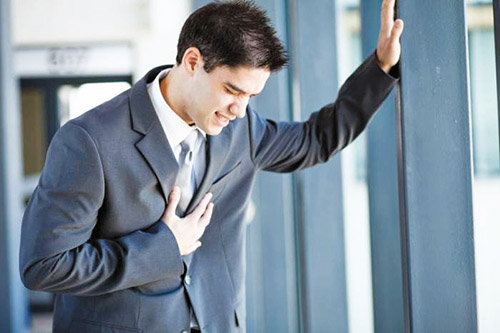

(Courtesy of SMGH) With COVID on everybody’s mind, it is very easy to forget that February is American Heart Month, and heart disease is still the No. 1 cause of death in the U.S. (COVID is No. 3).1 According to the Centers for Disease Control (CDC), in 2020, there were 696,962 deaths—one in five deaths in the United States were caused by heart disease. On average somebody dies of heart disease every 40 seconds in the U.S. Approximately one in five heart attacks is silent—the damage is done, but the person is not aware of it.2
And heart attacks are not age-dependent. Not long ago, it was rare for anyone younger than 40 to have a heart attack. Now, one in five heart attack patients are younger than 40 years of age. Between the years 2000-2016, the heart attack rate increased by 2% every year in this young age group.
Your outlook isn’t better following a heart attack just because you’re younger. Patients who have a heart attack in their 20s or 30s face the same risks as older patients. Once you have that first heart attack, you have the same chance of dying from a second major heart event or a stroke, regardless of your age.
So, how do we know what’s causing chest pain when we feel it?
Signs or symptoms of a heart attack are chest pain or discomfort; feeling weak, light-headed, or faint; pain or discomfort in the jaw, neck or back; pain or discomfort in one or both arms or shoulders; shortness of breath. However, some of these symptoms can be associated with a panic attack or even COVID, as seen in this chart:
Healthy Living
The American Heart Association (AHA) believes in eating smart, moving more, and “being well,” as three strategies that can benefit your heart’s health. When considering your diet, “check for the heart-check” mark or sticker on groceries you find at the store. These items, specifically chosen by the AHA, are a reliable source of nutrients and are limited in bad fats and sodium.
In addition, it is important to get and stay active outside. Even though the weather is cold, there are some great opportunities for staying active: hiking, skiing, building snow forts with the kids or snow shoveling. Stretch before and after, and make sure to stay hydrated Also consider indoor swimming and yoga. However, be careful. Hate to break the news, but you are not a kid anymore! To accompany healthy eating and exercise, it is important to regularly monitor your body as well. The AHA recommends controlling your cholesterol, managing your blood pressure, reducing blood sugar and stopping smoking altogether.
|
Chest Pain: Panic Attack, Heart Attack or COVID? |
||
|
Organized by like items across all attacks. |
||
|
Panic Attack |
Heart Attack |
COVID Attack |
|
Intense fear and the severe onset of four or more of these symptoms: |
These symptoms may appear 2-14 days after exposure to the virus |
|
|
Chest pain |
Chest pain or discomfort |
Fever or chills |
|
Palpitations |
Feeling weak, light-headed, or faint |
Fatigue |
|
Sweating |
Pain or discomfort in the jaw, neck or back |
Muscle or body aches |
|
Trembling |
Pain or discomfort in one or both arms or shoulders |
Cough |
|
Feeling short of breath |
Shortness of breath |
Shortness of breath or difficulty breathing |
|
Feelings of choking |
Sore throat |
|
|
Nausea |
Nausea or vomiting |
|
|
Chills |
Fever or chills |
|
|
Feeling dizzy or lightheaded |
Headache |
|
|
Numbness and tingling |
New loss of taste or smell |
|
|
Fear of going crazy |
Congestion or runny nose |
|
|
Fear of losing control |
Diarrhea |
|
Diagnosis and Treatment
The comprehensive Cardiac Services Program at St. Mary’s General Hospital is an award-winning care program specializing in invasive as well as non-invasive procedures, cardiovascular surgery, cardiac catheterizations with state-of-the-art imaging systems, electrophysiology services and more. The program pioneered the first successful open-heart surgery in New Jersey and continues to garner national accolades receiving 2021 Healthgrades’ 5 Star Recognition for Treatment of Heart Failure, and Coronary Interventional Procedures, as well as the Healthgrades Patient Safety Excellence Award. The American Heart Association recognized the program with the STEMI: Silver Plus, and Target: Type 2 Diabetes Honor Roll recognition.
St. Mary’s General Hospital—nationally recognized, locally preferred—among the top hospitals in America for health, quality, and patient safety. A center of excellence, the hospital has over 550 physicians and 1,200 employees, with every staff member committed to providing respectful, personalized, high-quality care—to satisfy patients’ needs and exceed their expectations. St. Mary’s General is a proud member of Prime Healthcare, which has more Patient Safety Excellence Award recipients for five consecutive years (2016-2020) than any other health system in the country, including a “Top 15 Healthcare System’ by Truven Health Analytics. To learn more about St. Mary’s General Hospital, visit https://www.smh-nj.com/ or Facebook at https://www.facebook.com/StMarysGeneral.
For more information, please contact George Matyjewicz, PhD, community liaison, at georgem@gapent.com
1 Mortality in the United States, 2020, data table for figure 4 https://www.cdc.gov/nchs/products/databriefs/db427.htm
2 Fryar CD, Chen T-C, Li X. Prevalence of uncontrolled risk factors for cardiovascular disease: United States, 1999–2010 pdf icon[PDF-494K]. NCHS data brief, no. 103. Hyattsville, MD: National Center for Health Statistics










